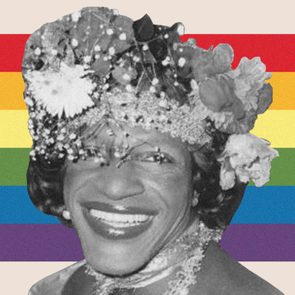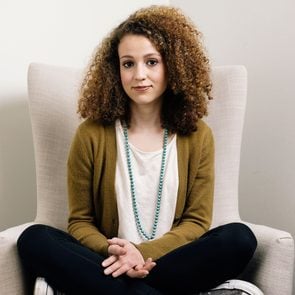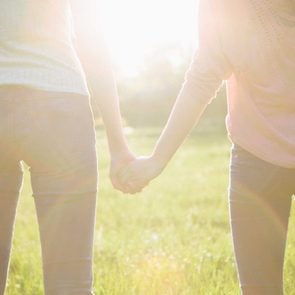What Does Non-Binary Mean? Understanding This LGBTQ Term and Why It’s Important
Updated: Jul. 09, 2024

Gender isn’t always a straightforward issue, but being respectful about how someone identifies is. Here’s what you need to know.
On government forms, social media account setups, and many other documents, you only get two choices for your gender: male or female. Sometimes it feels like the world is strictly divided along blue and pink lines, but there are other options. This is where non-binary comes in. It’s a term you’ve probably heard mentioned recently in relation to gender, but what does non-binary mean, exactly?
We talked with experts on gender and the LGBTQ+ community to find out what it’s all about and why it’s so important to people who don’t identify as cisgender. (More on that term later, too.) Believe it or not, many cultures throughout history have recognized non-binary identities, and those two “normal” options are actually a relatively recent invention. This Pride Month, as the LGBTQ community waves the rainbow flag high, it’s also important to recognize the many transgender and gender-diverse people who have gone down in history with memorable LGBTQ quotes and words of wisdom.
What does non-binary mean?
Non-binary is a word for people who fall “outside the categories of man and woman,” according to the LGBTQ+ advocacy group GLAAD. Because binary means “two,” if someone doesn’t identify as male or female, they could be non-binary. Non-binary folks may also use terms like “gender nonconforming” because they don’t conform to gender stereotypes. However, not all will. The LGBTQ+ community and the terms used to describe people are as unique as each individual. Gender identity is personal, according to Carrie Davis, Chief Community Officer for The Trevor Project, who says gender identity is our internal understanding and experience of our own gender. The question “what does non-binary mean?” is a little different for everyone.
GLAAD notes that the word non-binary should only be used to refer to a person who openly refers to themselves as such. The group also defines “gender expression” as the way we outwardly present our interpretation of gender, which can involve pronouns, a haircut, clothing, and more. That means non-binary people aren’t required to look a certain way; they could be masculine, feminine, or somewhere in between.
Is non-binary the only other option?
According to The Trevor Project’s research, LGBTQ youth are identifying with more than 100 combinations of terms to describe gender identity. Davis says many terms exist for identities that fall outside the binary, such as non-binary, genderfluid, genderqueer, polygender, bigender, demigender, or agender. “Gender diverse is used by some as an umbrella term to refer to these identities, which are similar but not necessarily interchangeable,” Davis says. In other words, non-binary is not the only option for people who don’t identify as male or female. If you’re wondering what non-binary means for you, there may be other options that resonate. It’s a good idea to spend some time reading up on GLAAD’s full list of terms to learn about them all.
RELATED: The Meaning Behind 24 LGBTQ Pride Flags
Does being non-binary also mean you’re gay?
Some may assume that because a person isn’t cisgender, they’re also gay. But that’s not necessarily the case. What is cisgender? A person who does identify with the gender assigned them at birth, and according to the Safe Zone Project, a non-binary or transgender person can be straight, gay, asexual, bisexual, or one of the many orientations cisgender people can be as well.
If I’m non-binary, do I have to come out?
If you’re ready to come out, that’s great! You could consider putting your pronouns in your social media bios or email signature. Some non-binary people use they/them pronouns, some use he/they or she/they, and others may create their own pronouns. However, some queer influencers forego labels altogether because they don’t feel comfortable choosing one. Davis says there are also situations in which someone may not be ready to come out or it’s not safe to do so.
“Unfortunately, coming out doesn’t always go according to our hopes and plans, and that can have a negative impact on one’s mental health,” Davis says. “The Trevor Project’s Coming Out: A Handbook for LGBTQ Young People is designed to support LGBTQ young people in exploring what coming out safely can mean.”
The good news is that there isn’t a single non-binary definition, and what gender means to you doesn’t change just because you aren’t out.
Do other cultures recognize non-binary people?
If you’ve never heard of non-binary identities or are new to coming out, you may not know there’s a long, storied history of cultures that don’t recognize the gender binary at all. While some cultures didn’t use the word non-binary, nor did they create a single non-binary definition, they had diverse gender roles.
Non-binary people have been around since at least 2,000 BCE, according to Out & Equal. According to some scholars, hieroglyphs from Ancient Egypt are believed to have recorded three genders: man, woman and an undefined third gender. Native Americans developed traditions for Two Spirit community members, and some tribes recognized as many as four genders. In 1776, a young Quaker known as Public Universal Friend became a genderless prophet; the Friend gathered hundreds of followers.
What struggles do non-binary people face?
Just because non-binary people have always been around doesn’t mean their lives are easy. Many face discrimination, and it can take a toll on their health, says Michelle Ruth, a licensed counselor in London. “If someone isn’t able to live as their authentic or true self, it can be traumatic,” Ruth says.
Non-binary people are also often misgendered, meaning that others may not always use the right pronouns for them. “When people are misgendered, it can be quite a triggering and traumatic experience,” Ruth says. “It can invalidate their existence and conjure up past feelings of anxiety and shame.” Beyond that, some people refer to them with homophobic slurs or harass them. In fact, transgender and non-binary people are often victims of violent crimes.
How can non-binary people take care of their mental health?
Ruth says there are many ways non-binary people can take care of themselves, like setting firm boundaries and keeping people who aren’t safe at “arm’s length.” She says tuning into your needs, seriously prioritizing mental health, and seeking supportive communities and allies are crucial. This can help reduce the emotional burden of taking it all on yourself. “Championing inclusivity and educating others can weigh heavily and feel like a big emotional burden,” Ruth says. “Be mindful of what you can tolerate emotionally. “
Additionally, the Trevor Project has a free hotline for LGBTQ+ people to call any time. Before losing a battle with depression, please call. The Trevor Project, Reader’s Digest, and the LGBTQ+ community support you.
How can people be better allies with LGBTQ+ and non-binary folks?
Although being non-binary isn’t always easy, cisgender allies can help. According to GLAAD, it’s important not to “out” anyone. What someone says in confidence can put them in danger if a family isn’t supportive, and some public places aren’t safe. Additionally, cisgender people can offer a listening ear to LGBTQ+ friends, and they can donate to GLAAD, the Trevor Project, and similar organizations that save queer lives. Lastly, cisgender people can educate themselves by learning about LGBTQ heroes and reading important LGBTQ books or even watching a few LGBTQ movies.
Being non-binary isn’t new, and both queer allies and the LBGTQ+ community can come together to understand the nuances of what this term means and to make life better for all gender-diverse people. It doesn’t need to be Pride Month for this to happen, of course—inclusivity is important all year long!
Sources:
- GLAAD Media Reference Guide: “Glossary of Terms”
- Carrie Davis, Chief Community Officer for The Trevor Project
- Out & Equal: “Nonbinary Gender Identities: A Diverse Global History”
- Women & The American Story: “Life Story: The Public Universal Friend (1752–1819)”
- Safe Zone Project: “Are all transgender people gay?”
- Indian Health Service: “Two-Spirit”
- Washington Post: “A genderless prophet drew hundreds of followers long before the age of nonbinary pronouns”
- Michelle Ruth, a licensed counselor in London
- HuffPost: “I’m Not A Woman Or A Man And Existing In This Binary World Is Really, Really Hard”





















